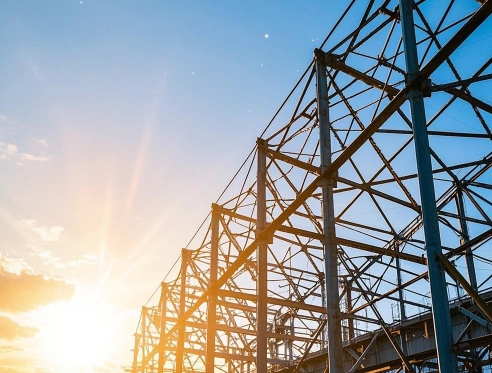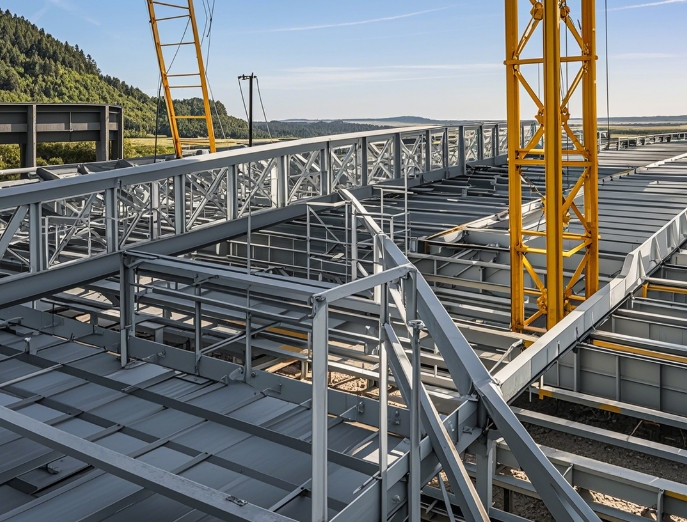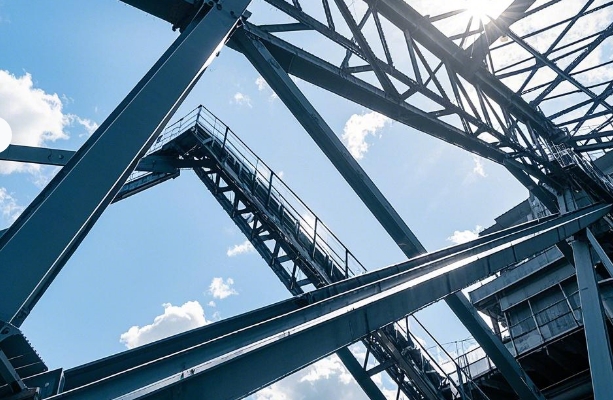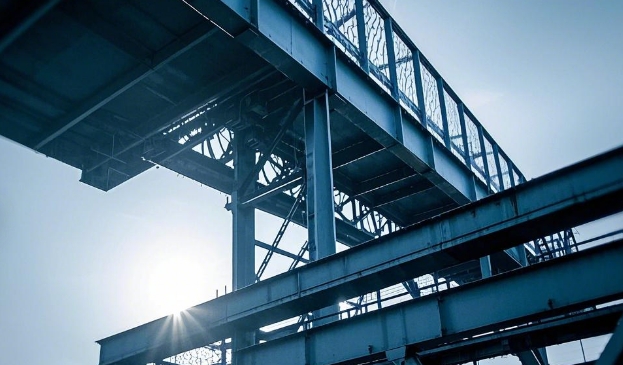Precautions for the processing and installation of bolted spherical grid structures
更新时间:2025-02-19 15:32:43•点击:294031 • Industry Views
In the field of construction engineering, bolted spherical grid structures are widely used in various large-scale building structures due to their excellent spatial stress performance, beautiful appearance, and convenient installation. However, to ensure the stability and reliability of the bolted spherical truss throughout its entire service life, it is necessary to strictly control every detail in the processing and installation process. The following are specific precautions.
Precautions for processing steps
Material quality control
Selecting high-quality steel that meets national standards is the cornerstone of ensuring the quality of bolted spherical grid structures. The chemical composition and mechanical properties of steel must be accurately matched with the design requirements, otherwise there is a high possibility of strength defects in the grid structure during subsequent use due to insufficient material properties, seriously threatening structural safety. During the procurement phase, procurement personnel need to carefully review the quality certification documents attached to each batch of steel. For key performance indicators such as yield strength, tensile strength, elongation, etc., strict spot checks should be conducted in accordance with relevant standards to ensure that each batch of steel meets the quality standards.
Precision of bolt ball machining
The machining accuracy of bolt balls directly affects the assembly quality and overall stability of the grid structure. Threading processing must strictly follow relevant precision standards to ensure a tight fit between bolts and screw holes, avoiding loosening, slipping, or inability to screw in properly. At the same time, the geometric dimensions such as diameter deviation and roundness error of the bolt ball also need to be strictly controlled within a very small range. Even small dimensional deviations may change the connection angle of the members, thereby affecting the force distribution of the entire truss and reducing its stability.
Rod processing
The length and straightness accuracy of the members play a decisive role in the installation quality of the truss. Excessive deviation in the length of the rod may result in inaccurate positioning during on-site installation, affecting the construction progress; If the straightness does not meet the standard, it will cause stress concentration in the member under stress, reducing its bearing capacity. During the cutting process of the rod, it is essential to ensure that the cross-section is smooth and free from defects such as burrs and missing edges, providing a good foundation for subsequent welding or connection operations and ensuring the strength and reliability of the connection parts.
Precautions for installation process
Basic acceptance
Before officially carrying out the installation of the grid structure, a comprehensive and strict acceptance of the foundation must be carried out. Focus on checking whether the key indicators such as the flatness, elevation, and axis position of the foundation are consistent with the design requirements. If there are problems such as unevenness, excessive elevation deviation, or axis offset in the foundation, the installation of the grid structure is prone to tilting, deformation, and other adverse conditions, which seriously affect the safety and normal use of the structure.
Measurement and laying out
Accurate measurement and layout work is a prerequisite for the correct installation of the grid structure. By using professional measuring instruments, the spatial position of each bolt ball and rod is accurately determined, and control points are reasonably set to provide accurate positioning basis for the subsequent installation process. At the same time, measuring instruments need to be calibrated regularly to ensure the accuracy and reliability of measurement data, and to avoid installation deviations caused by measurement errors.
Installation sequence
Following a scientifically reasonable installation sequence is the key to improving installation efficiency and quality. Normally, installation work starts from one end of the grid and gradually progresses in an orderly manner towards the other end. When installing, first fix the reference ball and rod to form a stable basic unit, and then gradually expand outward according to the pre designed order based on this, ensuring that the entire installation process is orderly.
Bolt tightening
Bolt tightening is the core step in the installation process. Use a calibrated torque wrench and strictly follow the torque values specified in the design for tightening operations, ensuring that each bolt is connected reliably and can effectively transmit loads. During the fastening process, a symmetrical fastening method should be used to avoid uneven local stress that may cause bolt loosening or connection failure. At the same time, clearly mark the tightened bolts to prevent missing or repeated tightening.
welding quality
Although bolted ball grids mainly rely on bolted connections, welding operations are still required in some special areas. During the welding process, it is necessary to strictly control the welding process parameters, such as welding current, voltage, welding speed, etc., to ensure the quality of the weld seam. Welders engaged in welding operations must hold corresponding qualification certificates, possess rich welding experience and proficient operating skills. After welding is completed, visual inspection and non-destructive testing should be carried out in accordance with relevant standards to promptly detect and eliminate welding defects, ensuring the strength and sealing of the welding area.
Installation process monitoring
During the entire installation process, real-time monitoring should be conducted on the deformation and displacement of the grid structure. By deploying professional monitoring equipment such as total stations and level gauges, timely deformation data of the grid structure during installation can be obtained. Once deformation or displacement exceeds the allowable range, the installation operation should be stopped immediately, the cause should be analyzed in depth, and effective adjustment measures should be taken to ensure that the installation quality of the grid meets the design requirements.
Precautions for processing steps
Material quality control
Selecting high-quality steel that meets national standards is the cornerstone of ensuring the quality of bolted spherical grid structures. The chemical composition and mechanical properties of steel must be accurately matched with the design requirements, otherwise there is a high possibility of strength defects in the grid structure during subsequent use due to insufficient material properties, seriously threatening structural safety. During the procurement phase, procurement personnel need to carefully review the quality certification documents attached to each batch of steel. For key performance indicators such as yield strength, tensile strength, elongation, etc., strict spot checks should be conducted in accordance with relevant standards to ensure that each batch of steel meets the quality standards.
Precision of bolt ball machining
The machining accuracy of bolt balls directly affects the assembly quality and overall stability of the grid structure. Threading processing must strictly follow relevant precision standards to ensure a tight fit between bolts and screw holes, avoiding loosening, slipping, or inability to screw in properly. At the same time, the geometric dimensions such as diameter deviation and roundness error of the bolt ball also need to be strictly controlled within a very small range. Even small dimensional deviations may change the connection angle of the members, thereby affecting the force distribution of the entire truss and reducing its stability.
Rod processing
The length and straightness accuracy of the members play a decisive role in the installation quality of the truss. Excessive deviation in the length of the rod may result in inaccurate positioning during on-site installation, affecting the construction progress; If the straightness does not meet the standard, it will cause stress concentration in the member under stress, reducing its bearing capacity. During the cutting process of the rod, it is essential to ensure that the cross-section is smooth and free from defects such as burrs and missing edges, providing a good foundation for subsequent welding or connection operations and ensuring the strength and reliability of the connection parts.
Precautions for installation process
Basic acceptance
Before officially carrying out the installation of the grid structure, a comprehensive and strict acceptance of the foundation must be carried out. Focus on checking whether the key indicators such as the flatness, elevation, and axis position of the foundation are consistent with the design requirements. If there are problems such as unevenness, excessive elevation deviation, or axis offset in the foundation, the installation of the grid structure is prone to tilting, deformation, and other adverse conditions, which seriously affect the safety and normal use of the structure.
Measurement and laying out
Accurate measurement and layout work is a prerequisite for the correct installation of the grid structure. By using professional measuring instruments, the spatial position of each bolt ball and rod is accurately determined, and control points are reasonably set to provide accurate positioning basis for the subsequent installation process. At the same time, measuring instruments need to be calibrated regularly to ensure the accuracy and reliability of measurement data, and to avoid installation deviations caused by measurement errors.
Installation sequence
Following a scientifically reasonable installation sequence is the key to improving installation efficiency and quality. Normally, installation work starts from one end of the grid and gradually progresses in an orderly manner towards the other end. When installing, first fix the reference ball and rod to form a stable basic unit, and then gradually expand outward according to the pre designed order based on this, ensuring that the entire installation process is orderly.
Bolt tightening
Bolt tightening is the core step in the installation process. Use a calibrated torque wrench and strictly follow the torque values specified in the design for tightening operations, ensuring that each bolt is connected reliably and can effectively transmit loads. During the fastening process, a symmetrical fastening method should be used to avoid uneven local stress that may cause bolt loosening or connection failure. At the same time, clearly mark the tightened bolts to prevent missing or repeated tightening.
welding quality
Although bolted ball grids mainly rely on bolted connections, welding operations are still required in some special areas. During the welding process, it is necessary to strictly control the welding process parameters, such as welding current, voltage, welding speed, etc., to ensure the quality of the weld seam. Welders engaged in welding operations must hold corresponding qualification certificates, possess rich welding experience and proficient operating skills. After welding is completed, visual inspection and non-destructive testing should be carried out in accordance with relevant standards to promptly detect and eliminate welding defects, ensuring the strength and sealing of the welding area.
Installation process monitoring
During the entire installation process, real-time monitoring should be conducted on the deformation and displacement of the grid structure. By deploying professional monitoring equipment such as total stations and level gauges, timely deformation data of the grid structure during installation can be obtained. Once deformation or displacement exceeds the allowable range, the installation operation should be stopped immediately, the cause should be analyzed in depth, and effective adjustment measures should be taken to ensure that the installation quality of the grid meets the design requirements.
Recommended Reading
-
Full analysis of seismic design and maintenance of grid structure
2025-02-27 16:16:52•1197820 次
-
What are the key process points to follow in order to ensure the quality of grid processing?
2025-02-27 11:21:00•115746 次
-
What type of construction is the grid mainly suitable for?
2025-02-25 16:42:00•111906 次
-
Quality control requirements of grid manufacturers!
2025-02-25 16:02:44•208075 次






